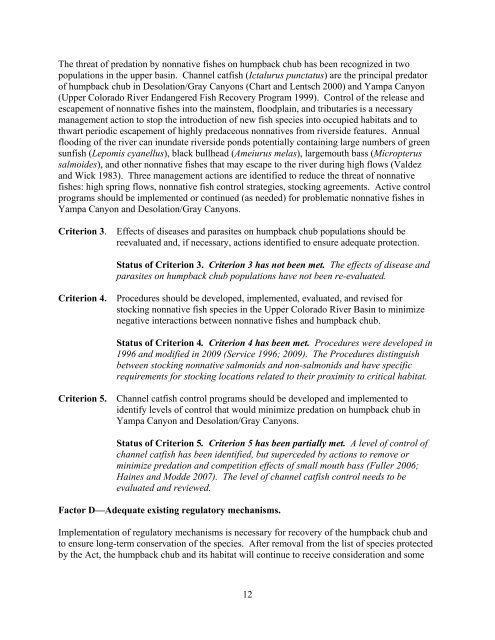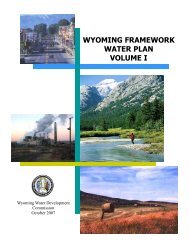Humpback chub (Gila cypha) - Upper Colorado River Endangered ...
Humpback chub (Gila cypha) - Upper Colorado River Endangered ...
Humpback chub (Gila cypha) - Upper Colorado River Endangered ...
You also want an ePaper? Increase the reach of your titles
YUMPU automatically turns print PDFs into web optimized ePapers that Google loves.
The threat of predation by nonnative fishes on humpback <strong>chub</strong> has been recognized in two<br />
populations in the upper basin. Channel catfish (Ictalurus punctatus) are the principal predator<br />
of humpback <strong>chub</strong> in Desolation/Gray Canyons (Chart and Lentsch 2000) and Yampa Canyon<br />
(<strong>Upper</strong> <strong>Colorado</strong> <strong>River</strong> <strong>Endangered</strong> Fish Recovery Program 1999). Control of the release and<br />
escapement of nonnative fishes into the mainstem, floodplain, and tributaries is a necessary<br />
management action to stop the introduction of new fish species into occupied habitats and to<br />
thwart periodic escapement of highly predaceous nonnatives from riverside features. Annual<br />
flooding of the river can inundate riverside ponds potentially containing large numbers of green<br />
sunfish (Lepomis cyanellus), black bullhead (Ameiurus melas), largemouth bass (Micropterus<br />
salmoides), and other nonnative fishes that may escape to the river during high flows (Valdez<br />
and Wick 1983). Three management actions are identified to reduce the threat of nonnative<br />
fishes: high spring flows, nonnative fish control strategies, stocking agreements. Active control<br />
programs should be implemented or continued (as needed) for problematic nonnative fishes in<br />
Yampa Canyon and Desolation/Gray Canyons.<br />
Criterion 3.<br />
Effects of diseases and parasites on humpback <strong>chub</strong> populations should be<br />
reevaluated and, if necessary, actions identified to ensure adequate protection.<br />
Status of Criterion 3. Criterion 3 has not been met. The effects of disease and<br />
parasites on humpback <strong>chub</strong> populations have not been re-evaluated.<br />
Criterion 4.<br />
Procedures should be developed, implemented, evaluated, and revised for<br />
stocking nonnative fish species in the <strong>Upper</strong> <strong>Colorado</strong> <strong>River</strong> Basin to minimize<br />
negative interactions between nonnative fishes and humpback <strong>chub</strong>.<br />
Status of Criterion 4. Criterion 4 has been met. Procedures were developed in<br />
1996 and modified in 2009 (Service 1996; 2009). The Procedures distinguish<br />
between stocking nonnative salmonids and non-salmonids and have specific<br />
requirements for stocking locations related to their proximity to critical habitat.<br />
Criterion 5.<br />
Channel catfish control programs should be developed and implemented to<br />
identify levels of control that would minimize predation on humpback <strong>chub</strong> in<br />
Yampa Canyon and Desolation/Gray Canyons.<br />
Status of Criterion 5. Criterion 5 has been partially met. A level of control of<br />
channel catfish has been identified, but superceded by actions to remove or<br />
minimize predation and competition effects of small mouth bass (Fuller 2006;<br />
Haines and Modde 2007). The level of channel catfish control needs to be<br />
evaluated and reviewed.<br />
Factor D—Adequate existing regulatory mechanisms.<br />
Implementation of regulatory mechanisms is necessary for recovery of the humpback <strong>chub</strong> and<br />
to ensure long-term conservation of the species. After removal from the list of species protected<br />
by the Act, the humpback <strong>chub</strong> and its habitat will continue to receive consideration and some<br />
12
















